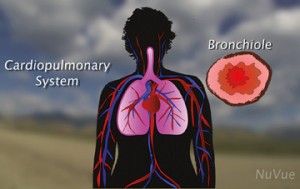Exercising With Asthma
Posted on November 1, 2012 by bob in Moving Free
 Asthma is a chronic disease of the airways in which bronchial passages become inflamed and narrowed in response to triggers like cold air, exercise, smoke, pet dander, dust mites and stress. Breathing becomes labored and difficult and in extreme cases, asthma attacks can be fatal. According to the National Institutes of Health, asthma affects about 25 million people in the U.S. and 300 million worldwide. The most common asthma symptoms are wheezing, shortness of breath and coughing. There is no cure, but modern medicine has provided options that help keep most asthma symptoms under control most of the time.
Asthma is a chronic disease of the airways in which bronchial passages become inflamed and narrowed in response to triggers like cold air, exercise, smoke, pet dander, dust mites and stress. Breathing becomes labored and difficult and in extreme cases, asthma attacks can be fatal. According to the National Institutes of Health, asthma affects about 25 million people in the U.S. and 300 million worldwide. The most common asthma symptoms are wheezing, shortness of breath and coughing. There is no cure, but modern medicine has provided options that help keep most asthma symptoms under control most of the time.
Exercising with asthma is a two-edged sword, since exercise is an irritant trigger and can induce asthma. In fact there is a whole category of asthmatics for which exercise induced asthma (EIA) is the main issue. However, this can be overcome.
Studies show exercising for fitness, particularly aerobic exercise, strengthens and builds the cardiovascular and pulmonary systems to the same extent as it does in non-asthmatics. Many Olympic and professional athletes have exercise-induced asthma; asthmatics can become very fit. So what kinds of exercise can and should asthmatics do, and what precautions should they take?
Pick an exercise that gets your heart rate up without putting too much pressure on your breathing. Generally, the most easily tolerated are low intensity activities; walking, biking, moderate aerobics, swimming outdoors where fumes from pool chemicals are less of an irritant. High intensity aerobics or calisthenics can be more problematic.
Some asthmatics have trouble with even low intensity exercise, while others can do almost anything most of the time. First and foremost consult your doctor before you begin. You may need to take medication, or take a puff or two from your inhaler before you begin. Use your peak flow meter and don’t exercise unless you’re in normal range.
Keep your emergency inhaler handy during exercise just in case. Avoid triggers whenever possible. If it’s too cold or the pollen count is high, exercise indoors. Exercise outside when the air is clear and humidity is higher. If you exercise in the cold, wear a scarf over your nose and mouth to warm and moisten the air as you breathe.
Stay hydrated by drinking plenty of water before, during and after exercise.
Take time to warm up with slow dynamic movements like marching in place or gentle stretching. Start slowly and monitor how the exercise is affecting you. Avoid sudden bouts of intense exercise.
Breath through your nose if possible in a relaxed controlled pattern. Try using pursed lip breathing by inhaling through the nose and exhaling through the mouth with lips pursed as though whistling. This helps avoid hyperventilation and manages shortness of breath by keeping your airways relaxed and dilated so you can expel carbon dioxide and take in oxygen. If exercise induces your asthma more severely, with your doctor’s approval, you may want to try easing in with gentle movements while seated in a chair.
Exercising with asthma is a very individual undertaking. Some people can do almost anything, while others have trouble with even light exercise. Talk to your doctor, listen to your body, start gently and build up. Stay in your comfort zone, take precautions, get fit and live well.
Mirabai Holland M.F.A. is a leading authority in the Health & Fitness industry and a public health activist specializing in preventive and rehabilitative exercise. Her Moving Free® approach to exercise is designed to provide a movement experience so pleasant it doesn’t feel like work (www.mirabaiholland.com).










